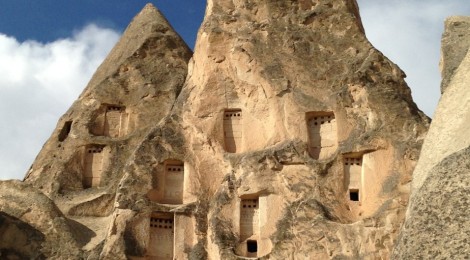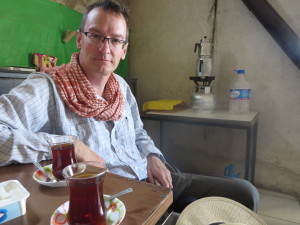
Of Cliffs and Caves: Cappadocian Carvings
Cappadocia is a glorious intertwine of geology and human need.
The need? Shelter.
The geology? Tuff: compressed volcanic ash. As a rock, it doesn’t live up to its name. A better name might have been ‘wimpy.’
The intertwine? Hand-hewn cave dwellings. In use today, in use for centuries.
We sleep in one each night. Yes, it has plumbing. Yes, it has a door and window. Yes, it is cool on the hot spring afternoons. Yes, it is quiet. So quiet that only the communal breakfast tells us how many people are actually housed at the Cave Life Pension.

It’s not all play: Alison snapped this shot of me working on the patio of our pension. We are surrounded by other hotels, restaurants, and family homes, many of which are carved deeply into the hills.
Yes, the tuff is so deep that you could dig down for eight stories and build a city of 10,000. The Phrygians started the work in the 8th-7th centuries B.C.E. and Derinkuyu Underground City was enlarged by Byzantine Christians in the 6th-7th centuries C.E. who wanted to hide from roving Persian and Arab armies. It’s just 30 km from our nighttime hutch in Goreme.
Yes, you could excavate a barn. Or an aviary. On our far-ranging walks through the valleys near Goreme we see hundreds of cliff side nesting spots hollowed out for pigeons. People have been carving pigeon roosts here for more than a thousand years, harvesting the droppings for fertilizer.
Yes, if you were so motivated, you could even carve churches and entire seminaries into the cliffs. That’s been done with varying degrees of sophistication and scale since the Byzantine Empire.
Unlike the Greeks or the Indians, the people of ancient and modern Cappadocia are primarily functional cave carvers. Yes, they can chisel in window or a table or a vat for tromping grapes (Grapes grow like weeds here.), but don’t count on them for either great architecture or achingly beautiful art.

The inside of a simple modern cave. We shared a cup of tea with the keeper of the Sakli Kiliese monument. This cave is his office. He doesn’t have running water, but he does have a cast-iron stove and chimney which he uses for warmth in winter. He kept a charming portrait of Ataturk. The light comes from the open door and from a light shaft carved in the roof.
If you need shots of grandeur or superb aesthetic, focus your senses on nature: the weather has been working the surfaces around Goreme for millions, not just a couple thousand years. There are dozens of valleys to explore: this one red-hued, that one white, another with many free-standing mushroom-like “chimneys,” and another with tunnels carved by flowing water.
My personal favorites are the towering, free-standing spikes of naturally worn sandstone that have just a touch or two of human intervention: an opening at the bottom and portholes a story or two above. They are high-rise hybrids between nature’s greatness and man’s inventiveness.
Your modern cave-man,
Chris


Recent Comments